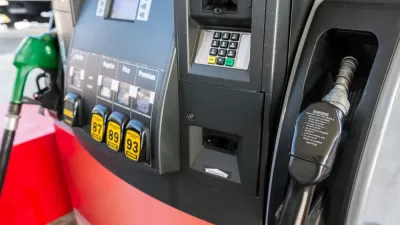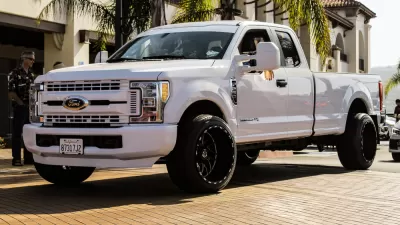Several key factors, not the least of which was cheap gas, combined to make 2015 a record year for new passenger vehicle sales, smashing the 2009 record of 10.4 million sales and edging-out the prior record of 17.40 million sales in 2000.
Other than the record number of vehicles sold, 17.5 million, what is most notable about 2015 sales is the changing composition of the American passenger vehicle fleet. As the caption under the accompanying graphic states, "car sales remained relatively flat, about 1 million more light trucks and SUVs were wold in 2015, a 13 percent jump from 2014." See below for more precise data.
"But because so much of buyers’ money went toward larger, gas-gulping trucks and SUVs, the sales boom conflicts with (an) administration campaign designed to encourage more efficient engines and less use of gasoline," write Drew Harwell and Steven Mufson for The Washington Post.
(T)he average fuel efficiency of new vehicles sold declined in 2015 to 25 miles a gallon, and U.S. consumption of gasoline rose 3 percent in 2015. [See related post.]
Increased SUV sales may imperil meeting President Obama's fuel efficiency goal—54.5 mpg by 2025.
Sales of slimmer passenger cars fell 2 percent last year compared with 2014, while sales of light trucks and SUVs soared 13 percent, estimates from industry researcher Autodata show.
It could have been worse. Unlike 2000, when larger SUVs like the Ford Explorer were best-sellers, Americans chose lighter SUVs like the Honda CR-V, which now compose the largest segment of the market at 14 percent, according to The Associated Press. While more fuel efficient than other light truck types (SUVs, pickup trucks and vans weighing <10,000 pounds per U.S. DOT [pdf]), these models are nonetheless displacing more fuel efficient subcompacts, compacts, hybrids, and electric vehicles.
According to AP, electric vehicle (EV) sales plummeted. The world's best-selling EV, the Nissan Leaf, saw U.S. sales drop 43 percent to "17,269, down from 30,200," from 2014, reports Auto Blog.
However, all was not bad for EV sales. "Tesla sold more than 50,000 Model S sedans in 2015, a new annual record," reports BGR.com.
As for those bike and transit-riding, Uber-using millennials living in dense cities who have no use for owning automobiles, they are now causing a "demographic shift" in auto sales, states the moderator in her video interview of TrueCar's Eric Lyman, who indicates that they are now a key driver in auto-sales.
Finally, most auto manufacturers reported record sales. One notable exception was Volkswagen, due to the "defeat device" scandal that is now the subject of a civil complaint filed by U.S. Department of Justice. AFP reports that their U.S. sales fell 5 percent in 2015, not bad considering the "25 percent drop registered in November after VW stopped selling diesel vehicles shown to have been equipped for years with software that intentionally subverted clean-air regulations."
FULL STORY: U.S. car sales hit record high in 2015

Maui's Vacation Rental Debate Turns Ugly
Verbal attacks, misinformation campaigns and fistfights plague a high-stakes debate to convert thousands of vacation rentals into long-term housing.

Planetizen Federal Action Tracker
A weekly monitor of how Trump’s orders and actions are impacting planners and planning in America.

San Francisco Suspends Traffic Calming Amidst Record Deaths
Citing “a challenging fiscal landscape,” the city will cease the program on the heels of 42 traffic deaths, including 24 pedestrians.

Defunct Pittsburgh Power Plant to Become Residential Tower
A decommissioned steam heat plant will be redeveloped into almost 100 affordable housing units.

Trump Prompts Restructuring of Transportation Research Board in “Unprecedented Overreach”
The TRB has eliminated more than half of its committees including those focused on climate, equity, and cities.

Amtrak Rolls Out New Orleans to Alabama “Mardi Gras” Train
The new service will operate morning and evening departures between Mobile and New Orleans.
Urban Design for Planners 1: Software Tools
This six-course series explores essential urban design concepts using open source software and equips planners with the tools they need to participate fully in the urban design process.
Planning for Universal Design
Learn the tools for implementing Universal Design in planning regulations.
Heyer Gruel & Associates PA
JM Goldson LLC
Custer County Colorado
City of Camden Redevelopment Agency
City of Astoria
Transportation Research & Education Center (TREC) at Portland State University
Jefferson Parish Government
Camden Redevelopment Agency
City of Claremont




























